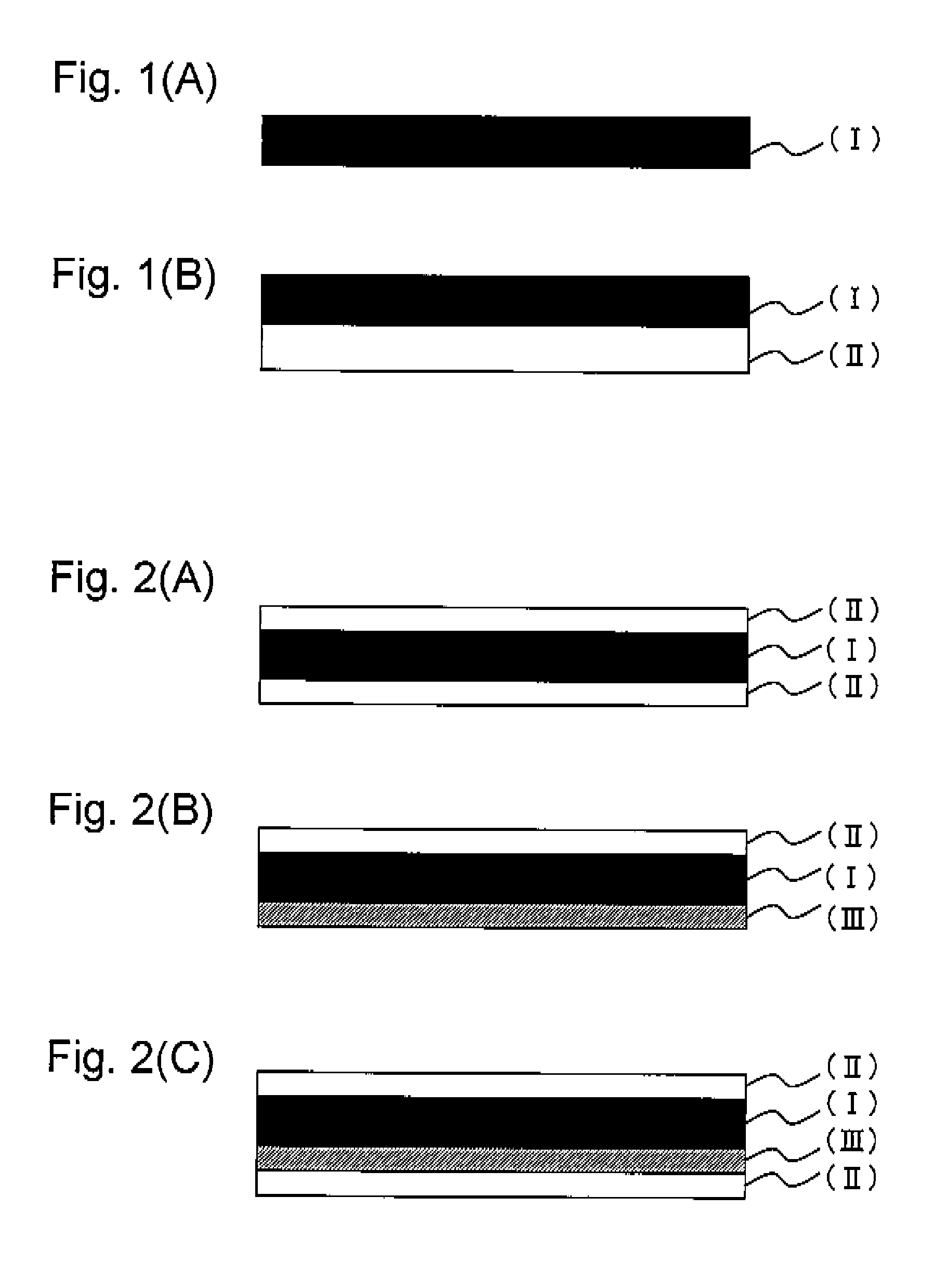Heat-shrinkable film, molded product and heat-shrinkable label employing the film, and container employing the molded product or having the label fitted thereon
a heat-shrinkable film and molded product technology, applied in the direction of transportation and packaging, mechanical equipment, other domestic objects, etc., can solve the problems of insufficient heat-shrinkable property, uneven shrinkage and wrinkles, and the major problem of recycling resources, etc., to achieve excellent heat-shrinkable property, mechanical properties, and excellent heat-shrinkable properties.
- Summary
- Abstract
- Description
- Claims
- Application Information
AI Technical Summary
Benefits of technology
Problems solved by technology
Method used
Image
Examples
examples
[0153]Hereinafter, the film, label, and the container having the label fitted thereon of the present invention will be described by way of the following examples.
[0154]Measured value shown in the Examples and the evaluation are as follows. In the Examples, the laminated film's drawing (flow) direction is referred to as “longitudinal direction” (or “MD” (Machine Direction)), and a direction perpendicular to MD is referred to as cross-wise direction (or “TD” (Transverse Direction)).
[0155]
(1) Storage Elastic Modulus (E′)
[0156]The polyolefin resin or the soft acrylic resin, both used for the present invention, were made into a sheet by heat stamping machine heated at a temperature range of 180-230 degree C. under the condition at a load of 20 MPa for 3 minutes and thereafter the sheet was immersed in cold water. The obtained film was cut into pieces having a size of 4 mm in width and 60 mm in length to make test pieces. Dynamic viscoelasticity about the respective test pieces were measu...
examples 1 to 12
, Comparative Examples 1 to 7
[0204]As for the first layer (monolayer) (Examples 1 to 12, Comparative examples 1 to 7), a mixed resin obtained by mixing the polylactic acid resin and the soft acrylic resin or the polyolefin resin respectively shown in Table 1 or 3, was fed into a biaxial extruder (manufactured by MITSUBISHI HEAVY INDUSTRIES, LTD.) and melt-mixed at a set temperature of 200 degree C.; after conducting extrusion from the extruding gate at a set temperature of 200 degree C., the obtained film was drawn by castroll heated at 50 degree C., then cooled and solidified to obtain a non-elongated laminated sheet having a size of 200 mm in width and 250 μm in thickness. Thereafter, by use of film tentering machine manufactured by KYOTO MACHINERY CO., LTD., the film was elongated in the width direction under the conditions shown in Table 1 or 3 to obtain a heat-shrinkable film.
examples 13 to 29
[0205]In addition to the first layer, as laminated films (Examples 13 to 29) having a second layer made of polylactic acid resin, pellet produced by feeding a mixed resin composing the first layer into the biaxial extruder (manufactured by MITSUBISHI HEAVY INDUSTRIES, LTD.) and melt-mixing at a set temperature of 210 degree C. and a mixed resin composing the second layer were respectively fed into the corresponding monoaxial extruders (manufactured by MITSUBISHI HEAVY INDUSTRIES, LTD.); after melt-mixing in each extruder at the set temperature of 210 degree C., co-extrusion through three-layer two-kind dies was conducted so as to have a film whose thickness of each layer is: (the second layer) / (the first layer) / (the second layer)=30 μm / 190 μm / 30 μm. The obtained film was drawn by castroll heated at 50° C., then cooled and solidified so as to obtain a non-elongated laminated sheet of 200 mm in width and 250 μm in thickness. Thereafter, by use of film tentering machine manufactured by...
PUM
| Property | Measurement | Unit |
|---|---|---|
| Fraction | aaaaa | aaaaa |
| Fraction | aaaaa | aaaaa |
| Time | aaaaa | aaaaa |
Abstract
Description
Claims
Application Information
 Login to View More
Login to View More - R&D
- Intellectual Property
- Life Sciences
- Materials
- Tech Scout
- Unparalleled Data Quality
- Higher Quality Content
- 60% Fewer Hallucinations
Browse by: Latest US Patents, China's latest patents, Technical Efficacy Thesaurus, Application Domain, Technology Topic, Popular Technical Reports.
© 2025 PatSnap. All rights reserved.Legal|Privacy policy|Modern Slavery Act Transparency Statement|Sitemap|About US| Contact US: help@patsnap.com


